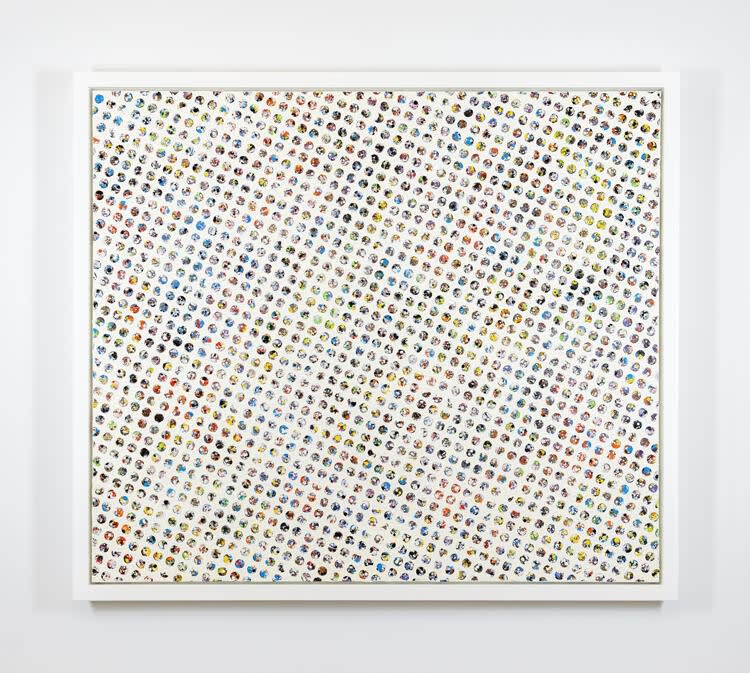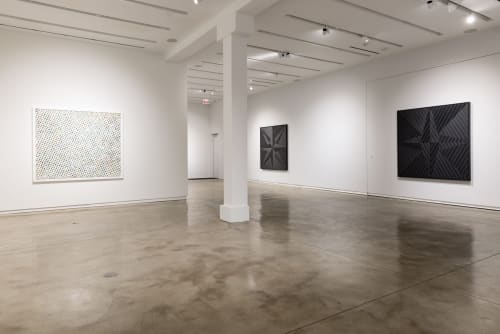
At Kavi Gupta, Chicago, James Little debuts meditative paintings that are about their own making
Abstractionist James Little debuts two sets of paintings from an ongoing thematic series at Kavi Gupta’s ominous black cube building in Chicago’s always-under-construction Fulton Market district. I mention the location of the exhibit because Little’s use of pattern and careful manufacture in ‘Black Stars and White Paintings’ reflects the construction techniques and industrial materials readily apparent in the surrounding streets. This is art about its own making.

James Little, Fat Star, 2022. Oil and wax on linen, 1.8 × 1.8 m.
Following the tradition of many non-objective painters, Little insists that he’s uninterested in narrative content: ‘The art world is overloaded with rhetoric and jargon. Just stop and put it on the wall and let’s see what happens,’ Little is quoted as saying on the gallery website. ‘If it performs, it performs. If it doesn’t, it doesn’t.’ But, while naming a painting comprised of two alternating black shades of oil and wax paint forming a symmetrical geometric shape Fat Star (all works 2022) is not a didactic declaration of meaning, neither is it noncommittal. At the very least, Little has a dry sense of humour.

James Little, Selfless Star, 2022. Oil and wax on linen, 1.8 × 1.8 m.
Though true, of course, of all painting, Little’s four ‘Black Star’ canvases – each a little under two square metres – benefit from close communion: he has reduced the palette and vocabulary of these works to a bare minimum. Each ‘Black Star’ is made up of four, equally sized square canvases: the sharp points of their central star shapes end at the four corners and in the middle of each side of the composition, where the canvases meet. On a laptop or, worse, a phone screen, these grave, dignified paintings might come off as generic vector graphic exercises. But, when you examine their surfaces up close, it’s clear that every inch was meticulously hand painted. Within each symmetrical, similar-seeming picture, there are unique moments – imperfections and peculiarities – that distinguish it from its siblings.

James Little, Spangled Star, 2022. Oil and wax on linen, 1.8 × 1.8 m.
Though they comprise simple shapes, nothing quite lines up flush in these works the way it might were they the product of a factory or a software program. Our minds tend to autocomplete the triangles and parallel lines that form these paintings but, upon closer inspection, many are cut off in the gutters between the four joined canvases, belying their uniformity. These irregularities are not mistakes: Little is not solving a math assignment. The ‘flaws’ make the viewer question what they’re looking at in a subtle and introspective manner; the making and remaking of these simple shapes anew is meditative.

James Little, Colored Neighbors, 2022. Oil on linen, 1.6 × 1.9 m.
The five ‘White Paintings’ – four of which are 1.6 × 1.8 metres; one of which is 1 × 1.1 metres – may not share the iconic punch of the ‘Black Stars’, but they’re full of small-scale pleasures. Three are composed in a checkerboard pattern, while two are circle grids; though hung straight, the patterns are all canted curiously 20 or 30 degrees left of centre. The viscous white of these paintings, their surfaces imprinted irregularly with remnants of cutting and measuring while still wet, reminded me of fossilized footprints: sure evidence of the artist’s hand. They alternate with kaleidoscopic colour quadrants that hint at worlds far beyond the strict grid in which Little has confined them. With titles like Colored Neighbors, these pictures allude to the mind of a painter deeply engaged in his social and political milieu, no matter the rigorous aesthetic constraints under which he operates. Little leaves a lot unsaid. The paintings do his talking eloquently.

